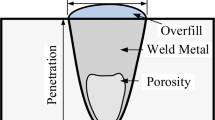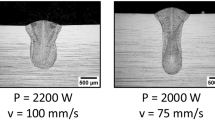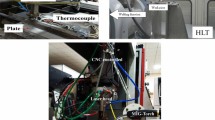Abstract
In this two-part article, the weldabilities of AA 1100 aluminum and AISI 409 stainless steel by the pulsed Nd:YAG laser welding process have been examined experimentally and compared. The effects of laser pulse time and power density on laser spot weld characteristics, such as weld diameter, penetration, melt area, melting ratio, porosity, and surface cratering, have been studied and explained qualitatively in relation to material-dependent variables such as absorptivity and thermophysical properties. The weldability of AISI 409 stainless steel was reported in Part I of this article. In the present article, the weldability of AA 1100 aluminum is reported and compared to that of AISI 409 stainless steel. Weld pool shapes in aluminum were found to be influenced by the mean power density of the laser beam and the laser pulse time. Both conduction-mode and keyhole-mode welding were observed in aluminum. Unlike stainless steel, however, drilling was not observed. Conduction-mode welds were produced in aluminum at power densities ranging from 3.2 to 10 GW/m2. The power density required for melting aluminum was approximately 4.5 times greater than stainless steel. The initial transient in weld pool development in aluminum occurred within 2 ms, and the aspect ratios (depth/width) of the steady-state conduction-mode weld pools were approximately 0.2. These values are about half those observed in stainless steel. The transition from conduction- to keyhole-mode welding occurred in aluminum at a power density of about 10 GW/m2, compared to about 4 GW/m2 for stainless steel. Weld defects such as porosity and cratering were observed in both aluminum and stainless steel spot welds. In both materials, there was an increased propensity for large occluded vapor pores near the root of keyhole-mode welds with increasing power density. In aluminum, pores were observed close to the fusion boundary. These could be eliminated by surface milling and vacuum annealing the specimens, suggesting that such pores were due to hydrogen. Finally, excellent agreement was obtained between experimental data from both alloys and an existing analytical model for conduction-mode laser spot welding. Two nondimensional parameters, the Fourier number and a nondimensional incident heat flux parameter, were derived and shown to completely characterize weld pool development in conduction-mode welds made in both materials.
Similar content being viewed by others
References
C.J. Nonhof: Material Processing with Nd-Lasers, Electrochemical Publications Ltd., Ayr, Scotland, 1988.
W.M. Steen: Laser Material Processing, Springer-Verlag, London, 1991.
ASM Handbook, vol. 6, Welding, Brazing, and Soldering, ASM INTERNATIONAL, Materials Park, OH, 1993.
J.T. Liu: Master’s Thesis, University of Waterloo, Waterloo, ON, Canada, 1991.
J.T. Liu, D.C. Weckman, and H.W. Kerr: Metall. Trans. B, 1993, vol. 24B, pp. 1065–76.
S.C. Wang and P.S. Wei: Metall. Trans. B, 1992, vol. 23B, pp. 505–11.
Welding Handbook, vol. 3, Materials and Applications, Part 1, American Welding Society, Miami, FL, 1996, pp. 25 and 28.
B. Thorstensen: in The Industrial Laser Annual Handbook, 1989 Edition, D. Belforte and M. Levitt, eds., PennWell Books, Tulsa, OK, 1989, SPIE vol. 1122, pp. 64–79.
D. Dubiel: Pract. Met., 1987, vol. 24, pp. 457–67.
H. Simidzu, F. Yoshino, S. Katayama, and A. Matsunawa: Laser Advanced Materials Processing, LAMP ’92, Proc. Int. Conf., A. Matsunawa and S. Katayama, eds., Nagaoka, Niigata, Japan, pp. 511–16.
A. Matsunawa: Laser Materials Processing, ICALEO ’94, Proc. Conf., Laser Institute of America, Orlando, FL, LIA, vol. 79, pp. 203–09.
M.J. Cieslak and P.W. Fuerschbach: Metall. Trans. B, 1988, vol. 19B, pp. 319–29.
L.A. Weeter, C.E. Albright, and W.H. Jones: Weld. J., 1986, vol. 65 (3), pp. 51s-62s.
C.A. Binroth, T.C. Zuo, and G. Sepold: Power Beam Technology, Proc. 2nd Int. Conf., The Welding Institute, Cambridge, United Kingdom, 1990, pp. 119–27.
E.J. Michaud, D.C. Weckman, and H.W. Kerr: Trends in Welding Research, Proc. 4th Int. Conf., H.B. Smartt, J.A. Johnson, and S.A. David, eds., ASM INTERNATIONAL, Materials Park, OH, 1996, pp. 153–58.
R.H. Fairbanks and C.M. Adams: Weld. J., 1964, vol. 43 (3), pp. 97s-102s.
R. Guenot and J. Racient: Br. Weld. J., 1967, Aug., pp. 427–35.
N. Rykalin, A. Uglov, and A. Kokola: Laser Machining and Welding, MIR Publishers, Moscow, 1975.
W.M. Steen: Lett. Heat Mass Transfer, 1977, vol. 4, pp. 167–78.
S.C. Hsu, S. Kou, and R. Mehrabian: Metall. Trans. B, 1980, vol. 11B, pp. 29–38.
J.A. Sekhar, S. Kou, and R. Mehrabian: Metall. Trans. A, 1983, vol. 14A, pp. 1169–77.
Y. Arata and I. Miyamoto: Plasma, Electron and Laser Beam Technology, ASM INTERNATIONAL, Metals Park, OH, 1986, pp. 245–62.
G.T. Martin and H.F. Bowman: Int. Comm. Heat Mass Transfer, 1990, vol. 17, pp. 93–104.
A.J. Russo, R.L. Akau, and J.L. Jellison: Weld. J., 1990, vol. 69 (1), pp. 23s-29s.
A. Paul and T. DebRoy: Metall. Trans. B, 1988, vol. 19B, pp. 851–58.
T. Zacharia, S.A. David, J.M. Vitck, and T. DebRoy: Metall. Trans. A, 1989, vol. 20A, pp. 957–67.
T. Zacharia, S.A. David, J.M. Vitek, and T. DebRoy: Weld. J., 1989, vol. 68 (12), pp. 499s-519s.
H.N. Bransch, Z.Y. Wang, D.C. Weckman, and H.W. Kerr: J. Laser Appl., 1991, vol. 3 (3), pp. 25–34.
Z.Y. Wang, J.T. Liu, D.M. Hirak, D.C. Weckman, and H.W. Kerr: J. Laser Appl., 1993, vol. 5 (1), pp. 5–12.
D.M. Hirak, D.C. Weckman, and H.W. Kerr: Meas. Sci. Technol, 1994, vol. 5, pp. 1513–32.
Ø. Grong: Metallurgical Modelling of Welding, The Institute of Materials, London, 1994, p. 21.
D.C. Weckman: WATWELDA, Waterloo, ON, Canada, 1996.
T. Zacharia, S.A. David, and J.M. Vitek: Metall. Trans. B, 1991, vol. 22B, pp. 233–41.
S. Kou: Welding Metallurgy and Weldability of High Strength Aluminum Alloys, WRC Bulletin 320, Dec. 1986, Welding Research Council, New York, NY, 1986.
L.W. Eastwood: Gases in Nonferrous Metals and Alloys, ASM, Cleveland, OH, 1953.
R.E. Trevisan, D.D. Schwemmer, and D. Olson: in Welding: Theory and Practice, D.L. Olson, R. Dixon, and A.L. Liby, eds., Elsevier Science Publishers, London, 1990, pp. 79–115.
K. Hong, D.C. Weckman, and A.B. Strong: Trends in Welding Research, Proc. 4th Int. Conf., H.B. Smartt, J.A. Johnson, and S.A. David, eds., Gatlinburg, TN, June 5–8, 1995, ASM INTERNATIONAL, Materals Park, OH, 1995, pp. 153–58.
Smithells Metals Reference Book, 7th ed., E.A. Brandes and G.B. Brook, eds., Butterworth Heinemann, Oxford, United Kingdom, 1992, pp. 17-1–17-12.
W.T. Walter, N. Solimene, K. Park, T.H. Kim, and K. Mukherjee: in Lasers in Metallurgy, K. Mukherjee and J. Mazumder, eds., TMS-AIME, 1981, pp. 179–94.
W.W. Duley: in Laser Surface Treatment of Metals, C.W. Draper and P. Mazzoldi, eds., Matinus Nihoff, Dordecht, The Netherlands, 1986, pp. 3–15.
T. Watanabe, Y. Yoshida, and T. Arai: LAMP ’92, Japan High Temperature Society, Nagaoka, 1992, pp. 505–10.
G. Kinsman and W.W. Duley: Laser Processing, Bellingham, WA, 1986, SPIE vol. 668, Society of Photo-Optical Instrumentation Engineers, Bellingham, WA pp. 19–22.
Y. Arata: Plasma, Electron and Laser Beam Technology, ASM INTERNATIONAL, Materials Park, OH, 1986, pp. 245–62.
K. Hong, D.C. Weckman, and A.B. Strong: Computational Fluid Dynamics and Heat/Mass Transfer Modelling in the Metallurgical Industry, CIM 35th Annual Conf. of Metallurgists, Montreal, Aug. 25–29, 1996, S.A. Argyropoulos and F. Mucciardi, eds., The Metallurgical Society of the Canadian Institute of Mining Metallurgy and Petroleum, Montreal, 1996, pp. 220–34.
E.J. Michaud, D.C. Weckman, and H.W. Kerr: Lasers & Electro-Optics, ICALEO ’94, Proc. 13th Int. Conf., T.D. McCay, A. Matsunawa, and H. Hugel, eds., Laser Institute of America, Orlando, FL, LIA vol. 77, pp. 651–60.
Author information
Authors and Affiliations
Rights and permissions
About this article
Cite this article
Weckman, D.C., Kerr, H.W. & Liu, J.T. The effects of process variables on pulsed Nd:YAG laser spot welds: Part II. AA 1100 aluminum and comparison to AISI 409 stainless steel. Metall Mater Trans B 28, 687–700 (1997). https://doi.org/10.1007/s11663-997-0043-1
Received:
Issue Date:
DOI: https://doi.org/10.1007/s11663-997-0043-1




